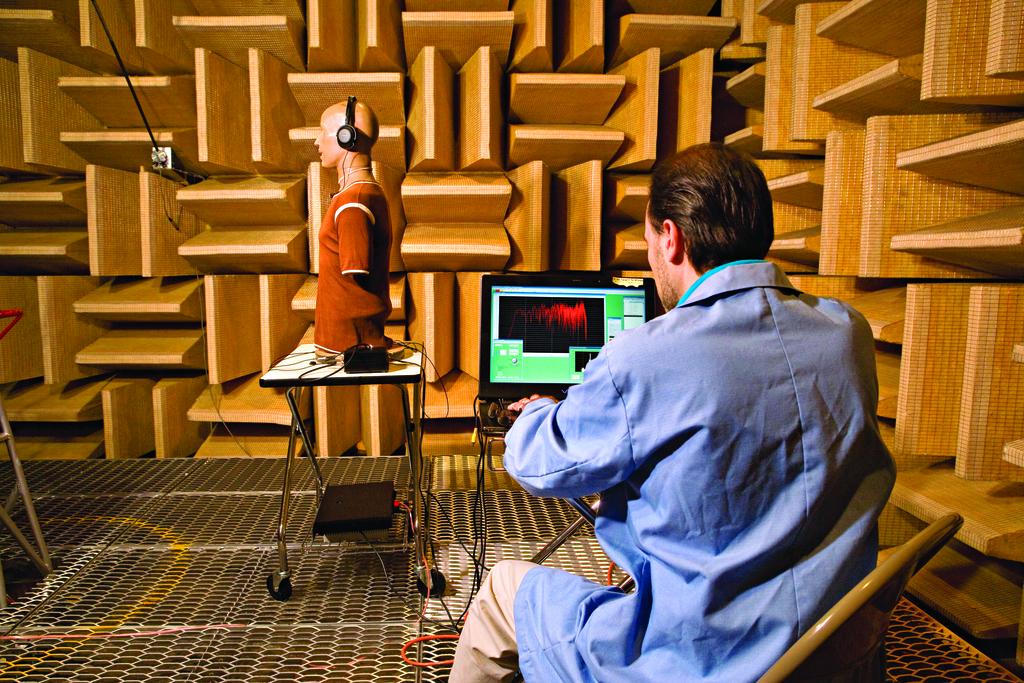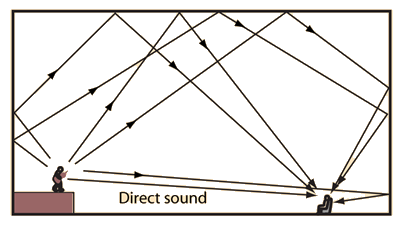음향장
Acoustic field
자유장
자유장은 음향 경로를 방해할 수 있는 장애물이 없이 음파가 전달될 수 있는 영역을 말한다.
이론적, 물리적으로 이상적인 상태의 공간을 말한다.
우리가 일반적으로 마이크로폰이나 스피커를 테스트 하는 무향실은 이 자유장에 근접하게 만들어진 공간을 사용하게 된다.
자유장은 주변에 장애물이 없는 개방된 공간을 의미합니다. 음향학에서 자유장은 음파가 자유롭게 전파될 수 있는 상태를 말하며, 주변에 벽면이나 장애물이 없어서 음파의 반사나 간섭이 없는 상태입니다.
자유장은 일반적으로 야외 환경이나 충분히 넓은 실내 공간에서 실현됩니다. 주변에 벽이나 바닥, 천장과 같은 반사면이 없기 때문에 음파는 주변에 자유롭게 퍼지게 됩니다.
자유장은 음향 측정 및 연구에 있어서 중요한 개념입니다. 이는 음향 장비나 시스템의 성능을 정확하게 평가하고, 음향 특성을 측정하고 분석하는 데 사용됩니다. 예를 들어, 스피커의 주변에서 충분한 자유장을 확보하고 마이크를 적절히 배치하여 스피커의 출력 신호를 정확하게 측정할 수 있습니다.
자유장은 음향학 연구뿐만 아니라 음악 제작, 방송, 라이브 공연 등 다양한 음향 환경에서 중요한 개념으로 활용됩니다. 자유장에서는 음파의 전파 특성과 속성을 정확하게 이해하고, 이를 기반으로 음향 시스템의 설계와 조정을 수행할 수 있습니다.
https://www.bksv.com/en/Campaign/HQ/M1-newsletters/M1-oct-2020/pressure-field-microphones
확산장
확산장은 자유장이 아닌 공간을 말한다. 확산장은 일반적인 공간처럼 소리가 반사되거나 산란이 되는 공간을 말한다. 따라서 이러한 공간의 특성에 따라 공간의 소리는 고유한 특성을 가지게 된다.
보통 일반적인 공간은 확산장에 속한다고 보면 된다.
리버브 챔버는 이러한 확산장의 특성을 극대화하여 만들어지는 공간이다.
확산장(diffuse field)은 음향학에서 사용되는 개념으로, 음파가 고르게 분산되어 전파되는 상태를 말합니다. 확산장은 주변에 장애물이나 반사면이 있어 음파가 반사되고 임의적으로 분산되는 상태를 의미합니다.
일반적으로 확산장은 방 안의 음파 전파를 모델링하는 데 사용됩니다. 예를 들어, 스피커로부터 방 안에 발생한 음파는 벽면이나 천장과 같은 반사면에서 반사되고, 반사된 음파는 임의적으로 분산됩니다. 이렇게 분산된 음파들이 방 안에서 균일하게 분포되면 확산장이 형성됩니다.
확산장은 일반적으로 방 안의 음향 환경에서 중요한 개념입니다. 음악 제작, 녹음, 음향 설계 등 다양한 분야에서 활용됩니다. 확산장은 음향 신호의 반사, 임펄스 응답, 에코 및 반사 간섭 등을 이해하고 분석하는 데 도움을 줍니다.
특히 스튜디오나 음악 제작 공간에서는 방 안의 음향 확산을 균일하게 조절하는 것이 중요합니다. 이를 위해 음향 처리 장치나 흡음재, 반사판 등이 사용되어 음파의 반사와 분산을 조절하고, 좋은 음향 환경을 조성합니다.
확산장은 음향학 연구와 음향 설계에서 중요한 개념으로 활용되며, 방 안의 음향 환경을 이해하고 최적화하는 데에 큰 역할을 합니다.
https://www.bksv.com/en/Campaign/HQ/M1-newsletters/M1-oct-2020/pressure-field-microphones
니어필드
근거리장
니어필드는 음향 공간에서 사용되는 개념으로, 스피커와 청취자 사이의 상대적으로 가까운 거리에서 오디오 신호를 듣는 것을 의미합니다. 니어필드 모니터링은 음향 엔지니어나 음악 제작자가 음악 믹스, 마스터링 또는 녹음 작업을 할 때 가장 일반적으로 사용하는 방식 중 하나입니다.
니어필드 모니터링 시스템은 스튜디오에서 작업할 때 청취자와 스피커 사이의 거리를 최소화함으로써 목표하는 효과를 달성합니다. 이를 통해 음악 제작자는 더 정확하고 직접적인 사운드를 들을 수 있으며, 스피커와 청취자 사이의 짧은 거리로 인해 반사음이나 간섭이 적어집니다.
니어필드 모니터링 시스템은 일반적으로 작은 크기의 스피커를 사용하며, 작업 공간의 특정 위치에 배치됩니다. 일반적으로 스피커는 작업 테이블 위에 위치하고, 청취자는 스피커와 동일한 수평선 상에 위치하며 작업을 수행합니다.
니어필드 모니터링은 믹싱 및 마스터링 작업을 포함한 오디오 작업의 정확성과 세부 사운드를 평가하기 위해 사용됩니다. 청취자가 스피커에 가까이 위치하여 음악의 세부 사운드, 믹싱 밸런스, 스테레오 이미지 등을 정확하게 평가하고 조정할 수 있습니다. 이를 통해 고음질의 오디오 작업을 위해 보다 정확하고 명확한 청취 환경을 제공합니다.
파필드
원거리장
파필드는 음향 공간에서 사용되는 개념으로, 스피커와 청취자 사이의 상대적으로 멀리 떨어진 거리에서 오디오 신호를 듣는 것을 의미합니다. 파필드는 주로 공연장, 컨서트 홀, 옥외 이벤트 등 대규모 음향 시스템에서 사용됩니다.
파필드에서는 스피커와 청취자 사이의 거리가 멀기 때문에, 음향 신호는 청취자에게 도달하기 전에 여러 환경적인 요인에 의해 영향을 받을 수 있습니다. 이러한 요인에는 반사음, 간섭, 공간적인 증폭/감쇠 등이 포함될 수 있습니다.
대규모 음향 시스템에서 파필드 모니터링을 위해 스피커는 청취자에서 상당히 멀리 떨어진 위치에 배치됩니다. 이로 인해 오디오 신호는 공간을 횡단하여 청취자에게 도달하게 됩니다. 파필드 모니터링 시스템은 대형 공연장이나 이벤트에서 필요한 음량과 커버리지를 제공하기 위해 설계됩니다.
파필드 모니터링은 음향 시스템 설계, PA 시스템 조정 및 공연장 청음 등에 중요한 역할을 합니다. 파필드에서는 스피커와 청취자 사이의 거리와 주변 환경 등을 고려하여 음향 신호를 조정하고 평가하는 작업을 수행합니다. 이를 통해 공연장 전체에 균일하게 분포된 음향을 제공하고, 멀리 떨어진 청취자들도 명확하게 오디오를 청취할 수 있도록 합니다.
무향실
자유장의 특성을 구현하기 위해 인위적으로 만든 공간.
장비의 특성을 측정하기 위해 주로 사용된다.
무향실(anechoic chamber)은 주변에서 발생하는 음향 반사를 최소화한 환경으로, 거의 완전히 무향한 상태를 만들어주는 공간입니다. 무향실은 주로 음향 연구, 음향 측정, 제품 테스트 및 개발 등의 목적으로 사용됩니다.
무향실은 음향 신호의 특성을 정확하게 측정하고 분석할 수 있는 환경을 제공합니다. 음향 연구 및 측정을 위해 사용되며, 스피커, 마이크, 음향 장비 등을 테스트하고 특성을 분석하는 데에 활용됩니다. 또한, 음향 신호의 방사 특성, 음향 임펄스 응답, 음향 특성 분석 등을 수행할 수 있습니다.
무향실은 실제 환경에서 발생하는 음향 반사와 간섭을 배제하고, 정확한 음향 측정과 연구를 가능하게 하는 중요한 공간입니다.
https://www.bksv.com/en/Campaign/HQ/M1-newsletters/M1-oct-2020/pressure-field-microphones
크리티컬 디스턴스
임계 거리
크리티컬 디스턴스는 음향학에서 중요한 개념 중 하나로, 음원과 청취자(또는 마이크) 사이의 거리를 나타냅니다. 이 거리는 음원에서 발생한 소리의 진행 방향, 음원의 성질, 환경의 반사 등 다양한 요소에 영향을 받습니다.
주로 크리티컬 디스턴스는 두 가지 영역으로 나뉩니다:
크리티컬 디스턴스의 정확한 값은 환경과 상황에 따라 다르며, 일반적으로 음원과 청취자 사이의 거리가 일정한 값 이상 커지면 원음의 정확도가 감소하고, 환경 반사음이 더 많은 영향을 미치게 됩니다. 크리티컬 디스턴스 이후에는 음향 공간의 특성, 마이크 또는 청취자의 위치 등을 고려하여 적절한 음향 처리나 조정이 필요할 수 있습니다.
크리티컬 디스턴스는 스피커나 청취환경에만 적용되는 것이 아니고, 마이크를 통해 소리를 녹음할 때에도 적용되는 개념입니다. 원음의 발원지와 마이크가 크리티컬 디스턴스보다 안쪽에 있다면 마이크를 통해 녹음되는 소리는 직접음 위주로 녹음되며, 마이크가 크리티컬 디스턴스 바깥쪽에 있다면 마이크를 통해 녹음되는 소리는 공간의 음향 특성에 따라 반사음이 섞여있는 소리로 녹음됩니다.
크리티컬 디스턴스를 이해하면 오디오 엔지니어나 음향 엔지니어가 스튜디오 설계, 음향 장비 배치, 라이브 음향 조절 등 다양한 상황에서 음원의 정확한 전달과 공간음향 대한 이해를 도울 수 있습니다.
https://hearingreview.com/hearing-loss/health-wellness/critical-distance
잔향
[공지]회원 가입 방법
[공지]글 작성 및 수정 방법



